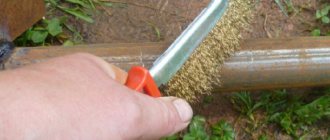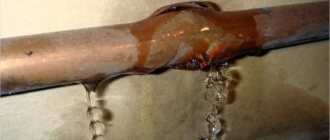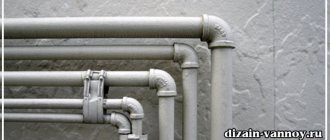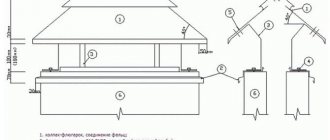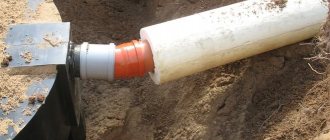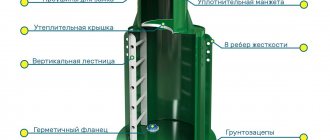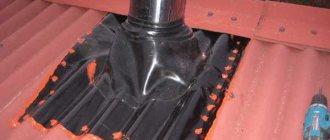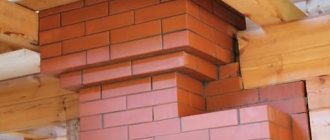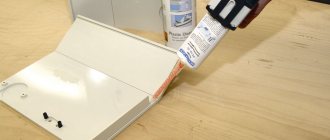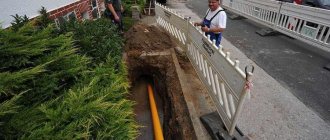Coordination of work on tapping into the water supply system
Only with the permission of the relevant authorities can work begin on inserting an additional pipeline into the centralized water supply system. It is important to complete all documentation before starting work. If all this is not done, then you may incur administrative and financial liability for the illegality of your actions.
So, you need to start the insertion procedure in order to obtain a plan of a specific site to determine the presence of various utilities laid underground. With this document, you can go to the water utility and make a statement about your desire to connect to the central water supply system. You must also have with you documents indicating ownership of a specific house or plot.
Technical parameters that you need to know about when connecting:
- strictly defined insertion point;
- diameter of the connected pipeline;
- other information required in accordance with the purpose of the work performed.
Then you need to obtain permission from the sanitary and epidemiological service. With all the above documents, you can begin to develop and sign the project and estimate for the work being carried out. Independently tapping into a pipe without turning off the water supply is strictly prohibited, as is installing metering equipment. For these purposes, there are specialists who can be called from the appropriate government or certified private organization.
It is also prohibited to insert into the following types of pipeline:
- large diameter trunk networks;
- pipelines that are subsequently not connected to the sewer drain;
- other types.
How to do it yourself or call a specialist
Work on tapping into the water supply system can be done on your own in terms of networks within a house or apartment boundary. The methods described above can be performed after preliminary training in the work or with the private involvement of an installation specialist. It’s a different matter when work needs to be performed on backbone networks outside the territory of private property. In this case, mandatory preparation and approval for the work of inserting an additional line is required.
READ ALSO: Soldering iron for polypropylene pipes - tool characteristics, selection parameters - Article - Magazine
Basics of tie-in
The determining factor when choosing the method by which the insertion will be made is the material used in the production of the central pipeline. Usually it is plastic, metal, metal-plastic, or less commonly found cast iron. Naturally, insertion is impossible without making a hole of the appropriate diameter, which means that when it is created, water will flow out of the pipeline. Only with the help of special clamp systems can everything be done with high quality.
A couple of basic rules for doing a sidebar:
- The internal diameter of the pipe that will connect to the larger pipeline must be equal to the diameter of the drill used.
- The outer diameter of the pipe should be slightly smaller than the hole into which it will be inserted.
The type of water supply affects how the insertion will be made. Most often we are talking about the use of welding and special clamps that allow work without draining water in the system. Clamps are also needed in cases where cutting the line is not at all possible. When working with polyethylene pipes, welding machines cannot be used.
When using welding, the water from the system will definitely have to be drained, and the inserted pipe must end with a coupling or thread for installing a root tap.
Sequence of insertion
The main device for carrying out the work will be a specialized drill, which allows you to drill a hole of the required diameter in a pipeline filled with water. By following safety precautions and rules for working with the tool, you can achieve increased productivity of this device.
Initially, you need to remove the insulating materials and clean the pipe in the place where the tap will be made. Then you need to install a flange with an outlet to the main pipeline. It is fixed with a clamp. It is necessary to install our tool on the valve that closes the flange. If you are cutting into a steel pipe, you should not use a clamp, but a pre-welded pipe.
When work with the welding machine is completed, it is necessary to check the resulting seam for defects. If there are any, then you can go over the contour of the seam again to make it as reliable as possible.
When the coupling (pipe) is ready, you need to insert a cutter of a certain diameter and cut a hole for inserting the pipe. The equipment is then removed and the valve blocks the flow of water in the coupling. Once the embedded pipe is welded, the insulation and anti-corrosion coating can be restored. In this sequence you can work with cast iron and metal pipes.
Existing types of clamps
Today, the construction market offers several types of clamps that can be used for insertion:
- clip - cannot be used when it comes to embedding a valve into a pipe under pressure, but for a cleaned system it is ideal due to its simplicity of design and low cost. It can be found in both metal and plastic versions;
- saddle - when working under pressure on asbestos-cement, metal or plastic pipelines, you need to use this type of clamp. The flow of water will be blocked by a special locking plate;
- drilling - as one of the structural elements of this product, a rotating bolt mechanism is used, which remains on the pipe as a shut-off or control valve;
- Electric welded saddle clamp is suitable for working with plastic pipes. It is initially supplied with a milling cutter of the required diameter. To install it you will have to use additional tools.
The polyethylene pipe is inserted into the water supply using the last two types of clamps.
Methods for inserting metal pipes
You can form a connection between metal channels in a pipeline using four types of fittings: threaded, saddle, clamps and couplings. The choice of one or another material is determined by the connection according to the detachability and curvilinearity of the path. Often you have to rely on the convenience of installation work, the experience and skills of the craftsman.
Threaded connection option
Connecting pipes with threaded fittings is suitable for non-pressure systems and chimneys.
Sectional view of a threaded unit
The formation of nodal contacts is permissible only in areas whose condition can be monitored in the public domain. This is important so that, if necessary, parts can be tightened at any time and replaced in a timely manner.
As a rule, pipes do not have finished threads, so they must be cut. If a new pipeline is being assembled, it is convenient to prepare the blanks using special equipment. A clamping system is provided here to prevent the workpieces from spinning. In place of the installed system, it is more convenient to work with manual analogues, which are limited in their functions.
So, a bench vise is used to fix the pipes. Next, the section that will be replaced with the fitting is cut out, and the cut is chamfered at a slope of 45 degrees. A thread similar to the connecting element is cut into a clean and even end using a tap. To simplify the process, it is recommended to use technical (machine) oil.
Threading kit
Connecting prepared pipes with threaded fittings involves the use of sealing materials. It can be linen, fum tape or special paste. It is important to first remove burred chips from the ends. The contacts are tightened all the way, but the effort cannot be exaggerated, as the fitting may burst.
By installing a clamp
The method of inserting into a metal pipe using clamps is otherwise called flange. The connection is detachable. The fitting is represented by a flat ring-shaped clamp with truncated ends, which is tightened with bolts. There must be a rubber seal inside to create a tight seal. The choice of parts is determined by the diameter of the pipes being connected.
Tapping with a clamp
The formation of a flange connection occurs according to the following algorithm:
- A cut is made in the pipe at a right angle. The more tightly the pipes fit together, the less pressure will be exerted on the clamp. It is not necessary to remove the chamfer here; it is enough to remove burrs from the edge.
- A gasket with a spacing at the ends of at least 10 mm is put on the joint.
- A flange is installed on top of the seal, followed by uniform (pairwise) tightening of the bolts.
It is worth noting that clamps are used only as a temporary connecting element. This is justified by the relatively low reliability of the seal. Its destruction or wear leads to weakening of the unit, which means loss of contact tightness.
By installing couplings
Coupling fittings belong to the group of crimp pipe fittings. Compression products are equipped with special rings, which after installation form a permanent crimp connection. A similar result is relevant for working with both gravity and pressure lines in a straight design. In this case, the diameter and nature of the pipes may vary.
Transition from metal to plastic using a coupling
The sequence of actions when installing a compression fitting is as follows:
- form a strictly perpendicular cut, clean the edges from burrs;
- the contacting areas of the working elements are treated with a sealing compound;
- the ends of the pipes are inserted into the fitting to a depth less than half the width of the coupling;
- adjust the position of the pipes for alignment;
- The nuts are tightened simultaneously to the limit using wrenches.
Installing a compression fitting is similar to the technology of inserting a tee for welding. A common feature is the loose contact of the coaxial ends of the pipes. To make it easier to adjust the immersion of the workpiece into the fitting, a mark is first applied to the first one with a marker or pencil. But the distance should not be significant, so as not to provoke delamination of the edges and the formation of a blockage.
A popular version of the compression fitting is the Gebo coupling. There are both crimp and sealing rings. And no specialized tool is required for the job.
Saddle tapping
A “saddle” is a flange fitting that has a third outlet in the center for a threaded connection.
“Saddle” with valve
You can connect another pipe or valve to it to a solid channel. The advantage of using such a device is the fact that installation can be carried out on an existing pipeline without stopping the flow of liquid. Experts also note that it is possible to work in hard-to-reach places, installation is carried out quickly even without relevant experience.
Installation occurs in the following sequence:
- a mark is applied under the hole, a starting recess is formed for convenience;
- the “saddle” is secured with bolts so that the central axis of the threaded outlet coincides with the mark;
- the valve with sealing material is screwed in;
- a hole with a diameter of 8-12 mm is drilled through an open tap until water comes out;
- the shut-off valve closes.
For drilling, it is permissible to use a cordless tool, a hand drill, or a brace, but not an electric analogue. The reason for this is the inevitable direct contact with water as the hole is formed. This is unsafe for the machine and humans.
Hand drill
The technology of pipe saddle connection is relevant for solving the question of how to embed a faucet into a metal barrel. Most often, installation is carried out using a welding machine. But if you find a flange of the required diameter, then the equipment will not be needed, and the valve can be easily replaced if necessary.
Connection to the main pipeline
When working with a main pipeline in which it is not possible to drain water, you must proceed as follows:
- First, get to the insertion site by digging out a significant layer of soil.
- Make a cut.
- Completely install the water supply circuit from the embedded element to plumbing fixtures or other objects.
Excavation work usually involves digging a pit of 150x150 centimeters. It is important to ensure that the bottom of the pit is slightly lower than the pipe (about 50 centimeters). Work can be carried out using an excavator, but no more than to a depth of 30-50 centimeters from the pipe itself, and then shovels are used. The location of the insertion point in the well greatly simplifies the work.
When using a “saddle” or a collapsible clamp, you need to puncture the reinforcement. This technology is similar to a tee on a water pipe, more familiar to inexperienced plumbers. A shut-off valve is screwed onto the side outlet, acting as a plug after a hole appears in the line. Read also: “Types of saddles for HDPE pipes, mounting and installation options.”
When working with plastic pipelines, it is permissible to use single saddle clamps or a combination such as a saddle-clip.
Polymer materials are best processed using an electric-welded collapsible clamp. Two parts of this design are mounted clearly at the insertion site, then soldered to the pipe. Such a connection has increased strength and absolute tightness.
The process is completed by diverting the side pipe from the clamp valve to the flow meter installed in the house.
What documents are required for tapping into the main water supply?
To obtain permission from regulatory authorities to perform the process, you need to prepare a package of documents:
- water supply connection project for the facility;
- diagram of the territory with all communications, fresh, on a scale of 1:500;
- documents confirming ownership of the plot or real estate;
- a letter to the responsible organization;
- technological connection conditions received from the operational owner of the networks.
In addition, it is necessary to send an application, along with the project, to the SES to receive confirmation of connection to the backbone network. The easiest way is to order a project from a specialized organization for correct and error-free calculation and execution. After receiving the documents from the SES, the package is ready for full approval by Vodokanal.
READ ALSO: How to clean pipes in the kitchen - All about sewage
Inspection well above the insertion point
Naturally, the location of the tie-in must be under the control of the owner of the house/site, because there is a risk of deformation of the connection, which will require prompt intervention. For these purposes, a special well (caisson) is created above the treated area. Work begins with the pit being deepened by 50-70 centimeters. The created depression is filled with gravel to a depth of about 20 centimeters, then roofing material is rolled out onto it and a concrete screed is poured into a layer of 10 centimeters. It is imperative to reinforce this layer using a reinforcement grid.
Concrete gains optimal strength (about 70%) in 3-4 days. Then a block shaft is installed above the concrete slab. Usually we are talking about a round or square shape.
A cast plate is placed on top of the shaft on the neck part, in which a round hole is made. Subsequently, a hatch will be installed in this place. The outer part of the shaft is coated with an insulating compound and filled with soil that was selected from the pit earlier.
Construction work involving the installation of a well requires significantly more time, effort and money than when inserting a water supply through a caisson. Getting to the underground part of the main canal is much more difficult.
Metal pipes and connections to them
If it comes to how to cut into a metal water pipe, then a saddle clamp with drilling comes to the aid of the worker. There are several structural varieties of this element. Before installing it on the pipe, you need to clean the selected area from corrosion damage and various contaminants. In addition to the standard semicircle, which is present in each clamp, there is a shut-off valve at the top of the structure. There is a hole made in it through which drilling will be done. A suitable drill bit is also provided. The two parts of the structure are placed on the pipe by fastening them together using conventional bolts.
The tightest contact between the clamp and the pipeline is ensured by inserting sealing rubber bands. Once the clamp is secured, you can start drilling the hole and closing it with a special screw as a plug. Subsequently, the clamp remains in place and is used as a shut-off valve. There are clamps into which the valve is initially screwed. The drill is removed from the hole made and the valve is closed.
Options for inserting into a plastic pipe
Let's look at how to cut into a plastic water pipe in different ways: by crimping a clamp with an overlay, connecting a manifold or tee, installing an electric welding saddle, and ensuring the cut through a pipe.
Installation of the trim clamp
This unit consists of two parts secured with clamps and bolts. The upper part is attached to the pipe through a sealing gasket that prevents water leaks. For good clamping, both parts of the pad must be selected to the appropriate size according to the markings.
In the first upper part there is a technological hole for connecting a new water supply line.
Possible connection via:
- Stopcock element,
- presence of a built-in cutter and safety valve,
- metal end in the form of a flange,
- Possibility of plastic end for gluing.
After placing the clamp with pads, I direct the upper part towards the planned branch of the new line. The assembly is fixed with bolts, which are pre-selected in size taking into account the diameter of the assembly. A special device is used to drill a hole in the line through the pipe of the mounted fitting.
This method also allows you to connect pressurized water to a plastic pipe. To do this, a built-in valve is installed in the unit, turning which drills a hole. After obtaining the desired result, the valve closes and the cutter rises.
READ ALSO: Plug for a water pipe - review and installation on
This is a very beneficial way to solve water connection problems in cases where it is not possible to stop the water supply or it is extremely inconvenient. This solution simplifies the procedure and makes it possible to carry it out online.
Clamp or collector device
Installing a tee can be called a classic solution to the problem. Together with the installation, prepared by removing part of the pipe from both sides, a separate part is mounted in the form of a tee or manifold. Next is soldering.
Electric welding saddle attachment
This mechanism resembles the method of attaching the lining described above, but with differences. It, just like a tee, provides a tight and reliable fastening through soldering at the molecular level of the material.
This is achieved by installing electric heating coils in plastic, which are welded with a special welding device that has a program configured for each unit to prevent overheating. After which the plastic, heated to a certain temperature not exceeding the critical temperature, sticks to the plastic and ensures tight and strong contact.
Insertion through a pipe
A good method for low pressure pipes. The principle of fastening is that it is installed on pipes using a pipe and a clamp, without welding. The elements of the device of the required diameter are selected, otherwise the unit may leak water. The fastening will allow you to quickly and easily install the outlet.
Choosing the best solution
Without a doubt, the most versatile and effective method, given the complexity of installing the unit, is overlays. Compared to other methods, it provides reliability and flexibility in installation.
Working with cast iron pipelines
A cast iron pipe can be drilled under pressure using special clamps with bimetallic crowns.
It is important to know the following features of this process:
- cast iron is an extremely brittle material, which requires caution from the worker;
- before drilling a pipe, you need to clean it from the anti-corrosion coating;
- it is unacceptable to overheat the crown on the clamp;
- the equipment should operate at low speeds.
After the stripping is completed, it is necessary to install a collapsible type saddle in place of the insertion. This place must be sealed with rubber pads. The pipe itself is drilled with a carbide crown, which simply cannot be replaced during the procedure.
The insertion sequence is as follows:
- The pipe is excavated and cleaned in the right place.
- The top layer of hot cast iron is cut using a grinder.
- A removable saddle is mounted. The joint between the reinforcement and the clamp is sealed using a rubber seal.
- The shut-off valve is then attached to the flange elbow required for insertion of the crown.
- The pipe is drilled with constant cooling of the cutting site.
- The crown is removed, and the water is shut off with a valve.
We must not forget about maintaining a constant slope of the embedded pipe towards the house. We are talking about a value of 2 degrees.
